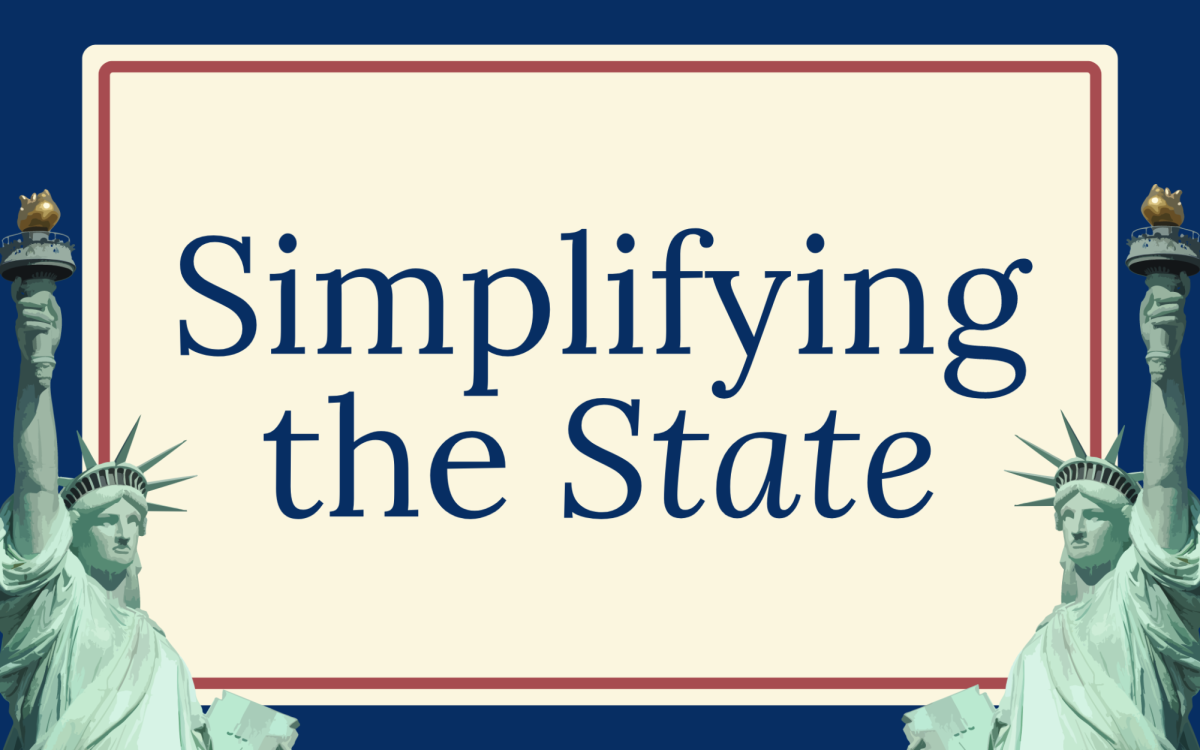Adam Watson (00:00)
Welcome back to “Simplifying the State,” the podcast where we break down politics so you don’t have to check your phone at lunch trying to understand why Southeast Asia is in turmoil again. As always, I’m Adam Watson.
Nicholas Perrin (00:10)
And I’m Nicholas Perrin.
Adam Watson (00:12)
All right, before we begin, if you’d be so kind as to rate us five stars wherever you’re listening—and share this podcast with a friend. If you enjoy it, they might too. And make sure to follow the podcast so you’re always alerted when we release a new episode. All that is greatly appreciated.
OK, so Nicholas, what do Alabama, Florida and Georgia all have in common?
Nicholas Perrin (00:36)
Are they all states that are in the Southern United States?
Adam Watson (00:40)
That is one thing they have in common. But what I was looking for is they’ve all passed laws—through their legislatures—to ban cellphones in schools. And that’s going to be our topic today: the phone bans that have happened here in Missouri, and how that fits into the larger national conversation around cellphones in schools.
So, Nicholas, want to give us a rundown of what states have restrictions and what that looks like?
Nicholas Perrin (01:15)
Yeah. So in most U.S. states—plus Washington, D.C.—there are policy requirements for schools around cellphone use. But schools usually have some autonomy in how they implement those policies.
In four states—Utah, Florida, South Carolina and Louisiana—there are specific, statewide rules every school has to follow. For example, in Florida, elementary and middle school students can’t use cellphones during the school day. High schoolers, though, are allowed to use them outside of class—during lunch, passing periods, or when a teacher allows it.
Florida is interesting because it was the first state to pass classroom cellphone restrictions in 2023. At that time, schools could still decide exactly how to enforce it. But now, they can’t. Since then, several states have followed with their own restrictions.
Some states—like Alaska, Washington, Connecticut, Kansas and South Dakota—have passed laws recommending specific policies but don’t require them. These laws usually include a model policy or outline what the restrictions should look like.
Another category of laws, in two states, focuses on incentivizing schools to restrict phone use. For example, in Pennsylvania, schools can receive grants to purchase phone pouches that hold students’ phones for the entire day.
There are exceptions to all these bans, usually for IEPs or medical reasons—like students who need to contact parents for health issues, such as diabetes.
These bans have seen wide support from educators and lawmakers. Some, like the one in Florida, passed with 100% approval in the state House. Among educators, only 17 % of teachers want phones in the classroom—but 51% still want students to have phones in school, largely for safety concerns.
Unsurprisingly, students are not happy about the bans. Neither are many parents. A poll from March last year found that 71% of parents wanted students to be allowed to have phones in school, and 38% supported allowing them in the classroom. Meanwhile, 91% of students favored being allowed to have phones in school, and 56% said they wanted to use them during class.
That said, in recent years, adults have become less enthusiastic about phones in school. Some studies show that removing them reduces fights and threats on campus.
So, Adam, what about Missouri?
Adam Watson (04:12)
Right. In July, the Missouri Legislature passed a bill—signed by the governor—that prohibits phone use in schools at all times. I’ll read from the bill:
Beginning in the 2025–26 school year, each school district and charter school shall adopt a written policy regarding students’ possession or use of electronic personal communication devices. Such a policy shall be designed to promote students’ educational interests and ensure a safe, effective working environment for staff and volunteers. At a minimum, the policy shall prohibit students from using or displaying these devices from the beginning until the end of the school day, including but not limited to during instructional time, mealtime, breaks, between classes and study halls. The policy shall also outline disciplinary procedures for violations and include exceptions for students who need devices due to specific educational or health needs, such as individualized education programs (IEPs) or 504 plans under federal law.
So this is one of the strictest phone policies in the country. According to the bill’s language, it’s a complete and outright ban on cellphone use during school hours—not just during class, which is already common.
This ban applies during lunch, passing periods, breaks—basically the entire school day.
This provision is set to expire Aug. 28, 2032. So it’ll be around well past when any of us graduates from high school.
In terms of public opinion, voters seem fairly supportive. A St. Louis University/YouGov poll showed that about 79% of likely voters support prohibiting students from accessing their phones during class.
Looking at political breakdowns:
- 82% of Republicans supported a full-day ban.
- 69% of Democrats supported it.
- 72% of all voters were in favor.
That was specifically about bans during regular school hours. For bans during class time:
- 85% of Republicans supported them.
- 72% of Democrats supported them.
- 79% of all voters supported them.
It’s also worth noting that the “not sure” category was higher when asked about full-day bans:
- 7% of Republicans, 15% of Democrats and 12% of all voters said they weren’t sure.
Compare that to just 5% of Republicans, 9% of Democrats and 7% of all voters who said they weren’t sure about bans during class.
So, clearly, phone bans during class are more popular than full-day bans.
Adam Watson (08:01)
Some of the concerns people have are about how to reach their kids in an emergency—like a school shooting (which unfortunately we have a lot of in America), or a tornado, earthquake or some other natural disaster. In those moments, the front desk may be overwhelmed with calls, and parents might not be able to get through.
Another concern is that taking phones away could damage student-teacher relationships. If a teacher confiscates a student’s phone, it could create resentment. However, that concern isn’t as widely shared.
One other argument I read is that these bans might make students feel less like they’re in a learning environment and more like they’re in prison—especially if their phone is taken and they can’t leave without a parent coming to pick them up. Some say that could make students feel like they have no freedom. Nicholas, what do you think about those concerns?
Nicholas Perrin (09:25)
Yeah, I mean, one of the big reasons behind these bans is mental health. But treating school like a prison and taking phones away could make that worse. It might actually cause more harm than good.
And then, yeah, in natural disasters or school shootings, it could become dangerous. Personally, I don’t think this is a great change. But I’m a student, so obviously I have some bias.
Adam Watson (10:01)
Yeah, same. We definitely don’t want our phones taken away. But seriously, the natural disaster concern feels especially relevant here in Clayton after the tornado we just had. If we couldn’t quickly reach our parents—or let them know we were OK—that would’ve made a stressful situation worse.
Nicholas Perrin (10:29)
Yeah, I completely agree. Especially with that tornado fresh in everyone’s memory, it’s understandable that people would be concerned.
Adam Watson (10:43)
Yeah. All right, well, thank you for listening to “Simplifying the State.” We’ll be back next week with our next episode about the current conflict going on in Southeast Asia between Thailand and Cambodia. We’ll break down what’s happening and why.
As we said at the beginning, if you liked the episode, give us a rating, share it with a friend, and make sure to follow. We’ll see you next time.









